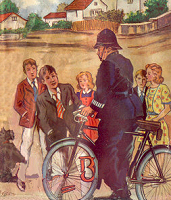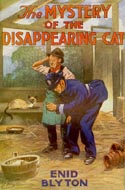
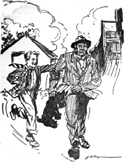
Mr Tupping does NOT like Buster, and he takes him away to lock him up.
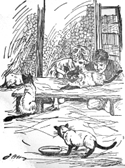
There's a strange smell in the cathouse. What could it be?
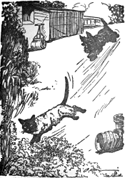
Dark Queen, the missing cat, shows up again—but Buster makes a nuisance of himself!
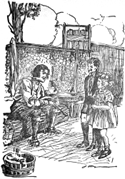
Poor Luke, the gardener's help, is the prime suspect. Did he steal the cat?
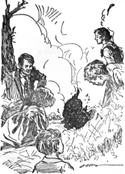
Buster finds a hole—and something is hidden in it!
The Mystery of the Disappearing Cat
Review by Keith Robinson (January 3, 2005)
The second mystery in the series is better than the first in some ways. Blyton seems more confident with her main characters here, who take on the sort of personalities and traits we're familiar with. It's almost like Burnt Cottage was a pilot episode, with the series really getting started with book two, Disappearing Cat. In this, Mr Goon throws his weight about more and Fatty lets loose all sorts of cheeky retorts. Bets and Buster also have a lot of work to do. And Inspector Jenks, true to form, shows up twice in his reassuring, twinkly-eyed way, cutting through the petty feuds between the children, Mr Tupping, Luke, and Mr Goon and talking a lot of sense. Inspector Jenks is a slice of reality dropping in on the pantomime village of Peterswood.
But it all works so well! Inspector Jenks is smart, as an inspector of police should be. He shows us that policemen are actually smarter than children, and that Mr Goon is really just a bumbling goon.
As for the mystery itself...Well, since it all takes place next door to Pip and Bets Hilton, there's not much running about except over the garden wall. Lady Candling's prize cat, Dark Queen (a valuable siamese), disappears right under the nose of Luke, the gardener's help. Mr Tupping, the gardener, is a nasty piece of work and the children immediately decide it would be great if he were the thief! But how could he be, if he wasn't even there when Dark Queen was stolen? All the evidence points to poor young Luke, Mr Tupping's helper, but the Find-Outers simply can't believe Luke is the thief. It's a mystery!
There are a couple of other possible suspects in Lady Candling's staff, such as Miss Harmer the cat handler, and Miss Trimble, who takes care of the roses. Miss Harmer has a tiny, bit part, but Miss Trimble—or Miss Tremble, as the children call her—is a very funny character, a nervous old woman whose glasses keep dropping off her nose. In this mystery there's really no question as to who did the dirty deed; it's like an episode of Columbo rather than Miss Marple. We're all pretty sure it was Mr Tupping...but how on earth did he do it? I remembered the clues pretty well: the small stone with a splash of tan paint on it, and the smell of turps in the cat house. The answer to the mystery is very simple and pretty clever—but it seems so obvious now that I'm just amazed I didn't guess it when I first read this book.
Blyton has a way of repeating herself at least three times in succession to really hammer home the facts and clues. First they'll discover something together; then one will say out loud what they've just seen; and finally one will recap the facts to make it really clear. But even though I kept rolling my eyes and thinking, "Yes, yes, we know!" this method does work well. Nothing is allowed to be forgotten. And having read this before, it was interesting to see how Blyton drops the clues in and cleverly brushes over them as "irrelevant"—whilst forcing her readers to remember them anyway.
Apart from lots of maddening punctuation typos (mainly missing speech marks), this was a good read, better I think than Burnt Cottage.
The Mystery of the Disappearing Cat
Review by Heather from Australia (January 12, 2005)This book was my first Find-Outers experience as a child, so it really remains very dear to me. I love the way Blyton brings all of the various characters back together even though Fatty was originally just on holiday in Peterswood. Luke next door always reminded me of my older brother—tall, hard working, very loyal—so my mental picture of Luke was always close to my brother's look: brown hair, green eyes, sudden grin but with a slightly tired look at times.
Blyton has written the character of Tupping very effectively. The reader has no choice but to hate him at first mention, and his treatment of poor Bets' strawberry plants almost had me in tears as a child. Lady Candling on the other hand hardly rates a mention through most of the book, which surprised me. Maybe Blyton thought that if she mentioned her kindness too much she may not have been a credible suspect when the time came. Also Miss Harmer, I think, deserved a little more time—she is barely even described and only pops up in the story when necessary to the plot.
Miss 'Tremble' is a wonderful character who also appears later in the series. I do think it is strange that Bets is so rude to her about her glasses and name—generally Bets is written as a very polite girl. It could be put down to her youthful exuberance, but to me it seems a little out of character for her.
Poor Bets has such a bad time in this mystery—getting stuck up the tree, the aforementioned strawberry runner incident, worrying about Luke going to prison, etc. She shows herself as a brave little girl and redeems herself for the many slips she has in both this and the previous mystery.
Larry steps down as the leader slightly (in attitude, not position) in this book—he begins to defer to Fatty's decisions and opinions a little more and hardly asserts his authority at all in comparison to the last book. Daisy plays a few more parts in this mystery—she helps to distract Miss Harmer and contributes her opinion a little more often.
Pip again laughs at his silly little sister and often feels the need to keep her in her place. He does show his kindness towards her though over the issue of the strawberry runners, and shows a great understanding of parents when he asks Bets to 'howl, will you' in order to get their way—I used the same technique myself as a child at times when I wanted something, and my children have tried similar things on me. They seem to think it's a new idea...


